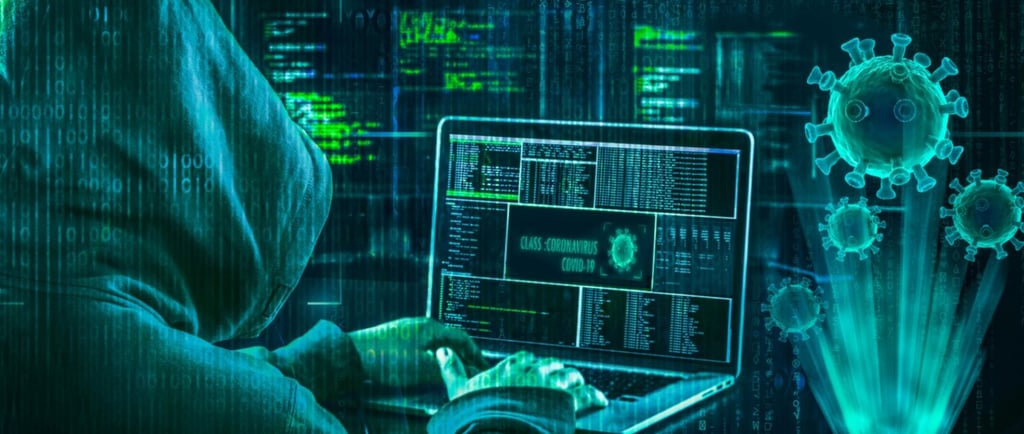Why Are We More Vulnerable Than Ever? The 6 Modern Cyber Risks You Can't Ignore
Feeling exposed online? Discover the 6 critical reasons why our digital world is at greater risk than ever, from AI-powered hackers to remote work vulnerabilities, and learn actionable steps to protect yourself and your business.
CURRENT NEWS


We live in a world of incredible digital convenience. We work from coffee shops, store priceless memories in the cloud, and connect with a global supply chain at the click of a button. But this hyper-connectivity comes at a cost: unprecedented vulnerability.
The question isn't if you will be targeted by a cyber threat, but when. The landscape of digital risk has evolved dramatically, moving far beyond the lone hacker in a basement. Today, we face a sophisticated, industrialized, and relentless threat environment.
Why does it feel like we're more at risk than ever before? The answer lies in a perfect storm of technological adoption, criminal innovation, and human behavior. This deep dive explores the six core reasons behind our collective vulnerability and provides a clear, actionable framework to build your digital defenses.
The 4 Pillars of Modern Cyber Risk: Why the Threat is Growing
1. The Remote Work Revolution: A Perimeterless Battlefield
The massive shift to remote and hybrid work isn't just a change of location; it's a fundamental dismantling of the traditional corporate "castle."
The Problem: Offices once had a single, fortified digital "moat" (the corporate firewall) that protected everyone inside. Now, every employee's home network is a new front door. These home networks, often secured with default router passwords and shared with vulnerable IoT devices like smart TVs and baby monitors, are easy targets.
The Attack Vector: Hackers use techniques like phishing emails tailored to remote workers (e.g., fake messages from IT support about VPN updates) to gain a foothold on a personal device. Once infected, that device can become a bridge into the corporate network if not properly isolated.
The Scale: This has created millions of new attack points for criminals to exploit, making the attack surface almost impossibly large to defend uniformly.
2. The Cloud Double-Edged Sword: Shared Responsibility, Shared Risk
Cloud services like AWS, Google Cloud, and Microsoft Azure are powerful, but they operate on a shared responsibility model. The provider secures the infrastructure, but the customer is responsible for securing their own data within that cloud.
The Problem: Many businesses, in their rush to digitize, misconfigure cloud storage buckets (like S3 buckets), leaving sensitive data exposed to the public internet without any password protection. These misconfigurations are alarmingly common and are constantly scanned for by automated bots.
The Attack Vector: Attackers don't need to break down a door; they simply walk through an open one. They use automated tools to scan the internet for these misconfigured resources, leading to massive data breaches.
The Scale: With so much of the world's data now residing in the cloud, a single configuration error can expose the personal information of millions of people.
3. Supply Chain Domino Effect: You're Only as Strong as Your Weakest Link
Modern businesses are ecosystems. You might have robust security, but what about your third-party SaaS provider, your HVAC contractor, or your open-source software library?
The Problem: Attackers have realized that targeting a single, smaller vendor can be the backdoor into all of their larger clients. This is called a supply chain attack. By compromising one piece of software or one service provider, they can compromise every organization that uses it.
The Attack Vector: The infamous SolarWinds attack is a prime example. Hackers inserted malicious code into a legitimate software update. When thousands of companies (including government agencies) installed the update, they unknowingly installed the backdoor themselves.
The Scale: This strategy gives attackers incredible leverage. One successful breach can cascade through an entire industry, making it one of the most potent and dangerous modern threats.
4. The AI Arms Race: When Hackers Have Smarter Tools
Artificial Intelligence is a powerful tool for good, but it's also a force multiplier for cybercriminals.
The Problem: AI allows hackers to automate and enhance every stage of an attack. They can use AI to:
Craft convincing phishing emails: AI-generated text is now flawless, free of the grammatical errors that once made phishing easy to spot.
Defeat CAPTCHAs: AI algorithms can solve visual puzzles designed to tell humans from bots.
Develop evasive malware: AI can write code that constantly morphs its signature to evade traditional antivirus software.
The Attack Vector: An AI-powered phishing campaign can generate thousands of unique, personalized emails in minutes, dramatically increasing the chances of someone clicking a malicious link.
The Scale: AI democratizes sophisticated hacking tools, allowing less-skilled criminals to launch highly effective campaigns, increasing the volume and quality of threats exponentially.
How Can You Protect Yourself? 6 Actionable Defense Strategies
Understanding the risk is only half the battle. Here is how you can fight back.
1. Adopt a "Zero Trust" Mindset: Never Trust, Always Verify
The old model of "trust but verify" is obsolete. The Zero Trust model operates on the principle that no user or device, inside or outside the network, should be trusted by default.
How to Implement:
Use Multi-Factor Authentication (MFA) on every account that offers it. This is non-negotiable.
Enforce the principle of least privilege, ensuring users only have access to the data and systems absolutely necessary for their job.
2. Fight Fire with Fire: Use AI to Defend Your Digital Perimeter
Just as attackers use AI, so should defenders. Security teams are now using AI-powered tools to:
Analyze network traffic in real-time to identify anomalous behavior that indicates a breach.
Automatically isolate infected devices before they can spread malware.
Predict future attack vectors based on global threat intelligence.
3. Fortify Remote Work: Secure the New Front Line
Protecting remote workers requires a layered approach:
Mandate a VPN: A Virtual Private Network encrypts internet traffic between an employee's home and the corporate network.
Endpoint Protection: Ensure every device used for work has reputable, next-gen antivirus/anti-malware software installed.
Security Training: Regularly train employees to recognize sophisticated phishing attempts and report suspicious activity.
4. Prioritize Patch Management: Seal the Cracks
Cybercriminals are like water; they flow through the path of least resistance. Unpatched software is that path.
Enable automatic updates for your operating system and applications wherever possible.
For businesses, implement a formal patch management policy to ensure critical security updates are deployed across the organization within a mandated timeframe.
5. Secure Your Cloud Footprint: Mind Your Configuration
The cloud is secure, but your use of it might not be.
Regular Audits: Conduct regular security audits and configuration checks of your cloud environments.
Encryption: Ensure all sensitive data stored in the cloud is encrypted, both at rest and in transit.
Training: Ensure your DevOps and IT teams are certified and trained in cloud security best practices.
6. Implement the 3-2-1 Backup Rule: Prepare for the Inevitable
Assume you will be hit by ransomware. A robust backup strategy is your ultimate insurance policy.
The 3-2-1 Rule means keep 3 copies of your data, on 2 different media types (e.g., cloud and external drive), with 1 copy stored offline and off-site. This makes it impossible for ransomware to encrypt your backups.
The Human Firewall: Your Best Defense
Technology is critical, but people are your most important layer of defense. A culture of security awareness is the ultimate deterrent.
Critical Thinking: Encourage employees to pause and think before clicking. Does that email from the CEO asking for gift cards seem right?
Healthy Skepticism: Verify unusual requests through a different communication channel (e.g., a phone call).
Shared Responsibility: Make cybersecurity everyone's business, not just the IT department's.
